
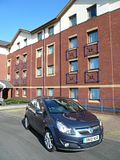



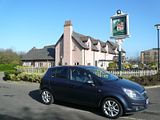

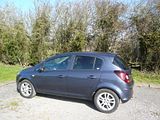
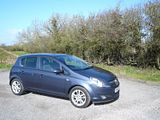
Even to the non-enthusiast, Vauxhall’s Corsa needs little introduction. Late to the supermini party, as, among other reasons, GM Europe lacked the production to capacity to build an additional model line until the completion of the plant in Zaragoza, the first generation Corsa (badged as Nova in the UK), made its debut exactly 30 years ago. Whilst there are unlikely to be many celebrations of this fact later in 2012, there is no denying that the Corsa has been an important model for Vauxhall-Opel ever since, notching up impressive sales totals in many European markets, and, with local adaptations, also in the growth markets of Latin America. Currently in its fourth generation, the Corsa has become more or less a permanent fixture in the UK’s Best Seller list, battling it out with Ford’s Fiesta to capture the hearts, minds and wallets of those who seek a practical, small and affordable hatchback. My only experience on the road with the current model Corsa was a couple of years ago, when I was handed the keys to a 3 door 1.2 SXi model, and I was rather less than impressed with many of the attributes of the car, finding it lacking power, noisy on the motorway and to have a poor ride. The supermini class is one of the most competitive in the market, and plenty has changed since then, so when Mr Hertz gave me the keys to a 5 door model, I was interested to see how the car fares in 2012.
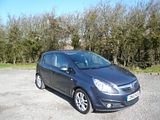
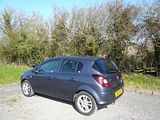


GM launched a mild facelift to the Corsa in early 2011, which as well as applying some of the family’s latest styling tweaks was intended to sharpen up the dynamics. My test car, though, turned out to be a 2010 model, and with a heady 38,600 miles on the odometer, and plenty of evidence of hard rental car life, so what I ended up with was simply a 5 door version of the same car that had so failed to impress in late 2009. Corsa is available in a wide variety of models, to suit the many and varied tastes and needs of its buyers. The test car was powered by the 1.2 litre petrol engine which finds it way under the bonnet of many of the cars, in favour of the 1.4 litre petrol, 1.3 diesel and the out and out sporting VXR cars. It develops 79 bhp, which is more than class competitive, as many of its rivals only develop this from 1.4 powerplants. That said, with the release of some clever new engineering in small capacity engines, such as Ford’s 1.0 litre triple and the Fiat Group TwinAir, we are clearly entering a phase where cubic capacity will become increasingly meaningless, and I expect cars to be badged according to power and not engine size.

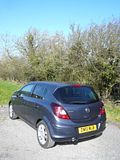
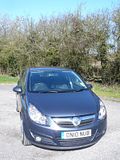

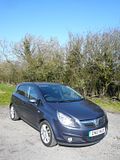
The worst mechanical evidence of the rigours of rental car life was manifest in an annoying squeak which could be heard on pressing and releasing the clutch pedal. It sounded like someone ripping back a tin lid and had I been going to retain the car beyond the one way journey from home to Heathrow, you would have seen me making strenuous efforts to swap the car for something else. Luckily, once on the motorway, you do not need to press the clutch pedal very often. There were other sources of noise to take over, though. Road and tyre noise is the most prevalent, and got pretty wearing pretty quickly. There is some wind noise as well, so the engine does not really stand a chance at making itself heard, which it probably would do were it not facing such vocal sound competitors. In so many modern petrol engines, the gearing tends to be optimised for emissions and fuel consumption, so they often come across as gutless. That in the Corsa, sadly, is no exception. Whereas 79 bhp ought to be ample to provide decent performance, the reality is that you need to use the gears a lot, and although the red line is at an ambitious 6500 rpm, the engine protests once you exceed 3000 rpm. It is fine in urban traffic, but out on the open road, you will get no enjoyment from the engine, and you will need to change down one or more likely two gears if baulked from a motorway cruising speed. The gearchange required some quite deliberate movements to navigate the lever across the gate, but otherwise moved cleanly with an appropriate measure of feel and resistance. Indeed, a discrete “shift up” arrow in the bottom of the rev counter, suggests, as all such systems do, that you change up a gear at quite moderate revs. The prize for all this, at least, was decent fuel economy. My calculations show a consumption of 38.4 mpg, assuming that the car was returned with the same level as at the start of the test, and were that not the case, as is so often true of rental cars, then the actual figure would be better still. Despite the attempt at a semi-sporting image, this is not a car for the enthusiastic driver. The steering has not got much feeling, getting lighter as you twist the wheel further from dead centre, and the handling is, well, predictable and safe, with just a hint of understeer evident. The 16″ wheels don’t help the ride, although I felt less evidence of all the different surfaces of our roads in this car than I did in the 3 door test car. No issues with the brakes, which did their job well. A conventional pull-up handbrake is fitted between the seats. With a far greater glass area over your shoulder, visibility is rather better than in the 3 door car, and with a good field of view available from the door mirrors, judging the extremities of the Corsa was not hard.

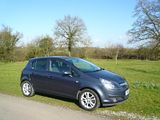
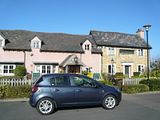
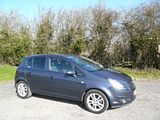

For many years, Vauxhall-Opel were certainly behind the curve in upgrading the quality of their interiors, though recent models have made strenuous efforts to try to address this, with some success, Superficially, the Corsa appears to be part of this trend, with good levels of design and assembly fit. However, poke a bit harder and all is not quite as good as it seems. In particular, the door casings are very hard and feel surprisingly unsubstantial, though at least the main dash moulding is of reasonable quality soft-ish touch plastic. In an effort to relieve the gloom of an all-black interior, the central section of the dashboard and the steering wheel spokes are inlaid with a silver trim, and there are some rather odd gloss ebony black finishers on the door pulls. The translucent dials on the air conditioning and main stereo knobs are probably a styling step too far, but the overall ambience of the interior is not too bad. The dashboard in this car is identical to that of the 3 door model, so I was quite surprised to find that, even though the test was on a lovely sunny spring day, the annoying reflections in the windscreen that I complained about in the 3 door test report were absent from this car. The main dials are presented under a cowled binnacle, with a large speedo and rev counter complemented by smaller fuel level and water temperature. The large dials have markings that are annoyingly small, and graduated in even increments of 20 mph, interpolation to judge 30 and 50 mph was quite difficult. The column stalks operate the indicators and wipers and are of the one-touch type that first came in with the Vectra a few years earlier. The ends are serrated and unpleasant to the touch, and I still find this set up fiddlier than the more conventional operation of stalks. Lights are operated from a rotary dial to the right of the column. The centre of the dash contains a digital clock in its own recessed display at the top of the dash, then beneath it the GM model audio unit and then the translucent rotary knobs for the air conditioning. It is all a lot less stylised and gimmicky than in the Fiesta, and to my mind, all the better for that. There is no driver’s footrest in this car, which is a pity.
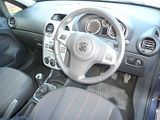
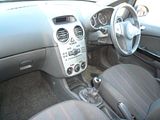
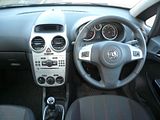
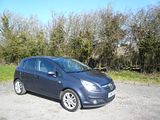
Particular praise is due to the sports-style front seats which proved very comfortable. The larger bodied may find them a little too bucket like, but for my frame, they were spot on, and can readily be adjusted up and down, as well as fore and aft. Even the cloth covering was less objectionable in both touch and appearance than the sort of cheap textile that you so often encounter these days. Those in the back may be less convinced, though with far larger side windows, at least the feelings of gloom and claustrophobia that they would get from the 3 door model are absent. In fact there is a decent amount of leg and head room, given the size of car, and shoulder room would be fine for two but very tight for three rear seat occupants. The boot is a regular shape, and easily accommodated my suitcase and lap top bag. More space can be created by dropping the rear seat backs drop onto the cushion, though this does create a less than level extended load area. In addition, you can make the regular boot floor higher, so it is flush with the tailgate sill, leaving a useful under floor area. Inside the cabin, there is a reasonable glove box, door bins, a small shelf moulding on the doors below the door release lever and small cubby areas both in front of and behind the gearlever for those odd and ends that you need to keep handy.
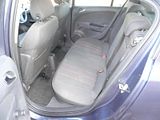
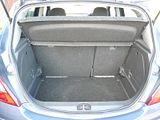

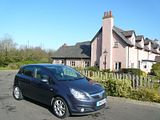
Ignoring the VXR models, Corsa is offered in 7 different trim levels: S, Activ, Exclusiv, SE, SXi, Limited Edition and SRi. An additional distinction is made for those cars with air conditioning fitted, so as an SXi a/c, my test car was towards the top end of the Corsa range. SXi is intended to denote a level of sportiness, so the features which it introduces largely evidence that, with 16″ alloy wheels, front fog lights, darkened smoked front and rear light and windows, sports front seats, a leather trimmed steering wheel, and what Vauxhall call “sports instruments”. You do also get cruise control, a multi-function trip computer and front and rear map-reading lights. Gone are the days when each model builds on the equipment levels of the one notionally “below” it, so you have to look at a set of trade-offs in considering the different variants. Both SXi and SE build on the features of the Exclusiv, but the SE adds items such as electrically heated front seats, rain sensing wipers and auto lights as well as many of the things that feature in the SXi specification. Compared to the cheapest models in the range, the Exclusiv brings side air bags, asymmetrically split rear seat, a height adjuster for the driver’s seat, an upgraded audio unit and different trim, along with 15″ wheels.
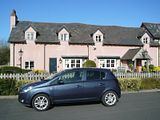



When, in autumn 2011, the highly regarded Autocar magazine conducted a test of 12 different superminis in this class, the Corsa made it into the top six, which was something of a surprise, perhaps only partly explained by the fact that one Steve Cropley seems to quite like the car. Corsa did not win the comparison, or even get a podium finish, but still it did receive an honourable mention. Of course, they tested the facelifted model, and I did not, so I cannot be sure that I would agree with all their findings or not, but on the evidence of this test, along with my broadly similar conclusions from sampling the three door car, and experience of testing other class competitors, this is not the car I would choose if selecting a supermini. Indeed I would rate it, at least in 1.2 SXi format as in the bottom half of the class. That’s not to say that for those who simply want a car that is cheap and easy to run that it is not worth consideration, as in absolute terms, it is not that bad a car. It is simply the case that there are plenty that are “better”. As with so many cars, sales success is not as directly linked to product excellence as one might think.
2012-03-27 07:22:39






































































